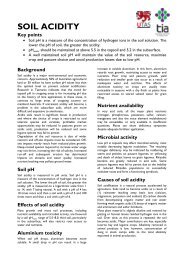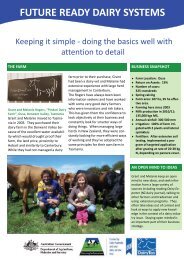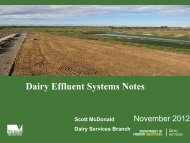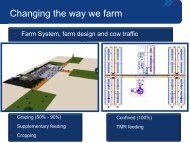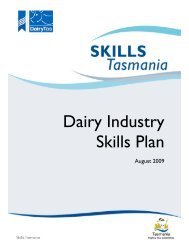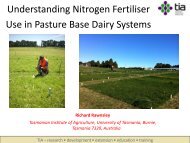You also want an ePaper? Increase the reach of your titles
YUMPU automatically turns print PDFs into web optimized ePapers that Google loves.
<strong>Dairy</strong> <strong>Effluent</strong>: <strong>Pumps</strong> <strong>and</strong> <strong>Sumps</strong>Updated: August 2007Note Number: AG0430ISSN 1329-8062Matthew Janssen, KyabramMany dairies can utilise their effluent by pumping directly from a sump to pasture. This optimises the utilisation of thenutrients in the effluent <strong>and</strong> therefore can be an inexpensive management option. The main disadvantage is that duringwinter, effluent should not be applied when additional water can cause pugging <strong>and</strong> pasture damage. The pasture nutrientrequirement at this time is also low <strong>and</strong> the potential for effluent run-off <strong>and</strong> nutrient leaching is high.Pumping from sumps may also be essential when gravity cannot be used to move effluent from the collection outlet in theyard to a storage facility.<strong>Sumps</strong>The sump is normally located where it can collect the gravity flow of effluent from the dairy yard, pit <strong>and</strong> milk room. This canthen be pumped to a storage facility or directly to l<strong>and</strong> application.A pumped sump can be quite successful in pumping effluent with entrained solids. Unfortunately materials such as balingtwine, wire, cow horns <strong>and</strong> straw have difficulty passing through a pump thereby causing blockages.To reduce maintenance <strong>and</strong> maximise pump performance a number of good practices should be incorporated into thedesign of any pumped sump.Pumped sumps - Good practicesSolids removalNon-manure solids in the effluent should be removed before the pump.This will extend pump life <strong>and</strong> lower maintenance costs <strong>and</strong> problems. A stone trap located before the sump consisting of asimple depression or settling chamber will collect heavier non- floating solids in the effluent stream.Stone traps have to be cleaned out regularly, otherwise, material will fill the trap <strong>and</strong> make it ineffective. The size of the trapshould be sufficient that it will hold the material collected from at least one milking. The trap must be easily accessible forcleaning with a shovel.For larger herds especially where coarse track material is used, larger trafficable solids traps (Figure 2) can be utilisedbefore a pumped sump. Solids traps simplify the process of solids separation, as well as being trafficable <strong>and</strong> self- draining.The trap is cleaned out every few months with a front-end loader, reducing cleaning time <strong>and</strong> contact with effluent. Design<strong>and</strong> construction requirements are detailed in the Agriculture Note; <strong>Dairy</strong> effluent: Trafficable solids trap.
Figure 1. A common pumping sump used in the dairy industry – can be round, rectangular or squareFigure 2. Trafficable solids trap <strong>and</strong> pump sumpSloping floorA sloping floor of approximately 45° will direct solids in suspension directly to the pump inlet resulting in less sludge build upthereby lowering maintenance time.Provision of an emergency overflowIn the event of pump failure or blockage the provision of an emergency overflow will keep effluent away from the pumpmotor <strong>and</strong> switchgear. Any overflow must be directed away from the dairy <strong>and</strong> where it won't pollute watercourses.Inflow into the bottom of sumpsTo maximise pump efficiency effluent should enter at the base of a sump. Avoid turbulence of cascading flows from the inletpipeline, channel or stream to minimise air entrapment, which can adversely influence pump <strong>and</strong> delivery line performance.If a cascading fall into a sump cannot be avoided, there must be sufficient length <strong>and</strong> depth to the pump inlet tocompensate.Adequate pump inlet submergencePump sumps should be of sufficient size to allow for satisfactory intake of water into the pump suction. Clearance betweenthe bottom of the sump <strong>and</strong> bottom of the suction pipe should be an absolute minimum of 100mm. Clearance between side<strong>and</strong> end walls should also be a minimum of half pipe diameter.The water level in the sump should not be less than one <strong>and</strong> a half times the pipe diameter above the suction (see figure 3).If this is not the case, air can be drawn into the inlet. A vortex could also be created causing a rotation of the intake water.This could cause vibration <strong>and</strong> cavitation of the pump.
Sump volumeSump capacity <strong>and</strong> shapes can be designed differently to match different site requirements, pumping arrangements <strong>and</strong>management schemes.Small diameter pipes have been used as sumps for pump installations servicing milking sheds. These sumps are usually450 mm to 900 mm in diameter <strong>and</strong> 1.2 metres deep. This arrangement offers little buffer storage thereby needing a pumpwith a similar capacity to the peak inflow rates. In the event of pump failure an overflow will occur. Access for cleaning canalso be restricted due to the small diameters. Larger sumps will overcome the issues identified above <strong>and</strong> will also providegreater flexibility in the management of the pumping system.Larger sumps are advocated to provide storage for 4 to 6 milking's, or at least storage for 1 milking. This allows time forpump repairs in case of breakdowns <strong>and</strong> allows for easier access for cleaning.A larger sump also allows greater flexibility in pump selection thereby optimising performance <strong>and</strong> minimising operatingcosts. <strong>Pumps</strong> turning on <strong>and</strong> off constantly will also increase the chance of a burn out. Therefore bigger sumps allow timebetween pumping to be maximised. The sump depth should be matched to the column length of the pump to ensure idealflow conditions.<strong>Pumps</strong>Pump selectionWhen pumps are used to transport dairy effluent, problems can arise if unsuitable equipment is used. Factors to consider inthe selection of an effluent h<strong>and</strong>ling pump include:• pressure or head requirements• flow rate• effluent volume• the solids content of the effluent stream• power source• suction <strong>and</strong> priming characteristics• quality of components• maintenance• reliability <strong>and</strong> price.Pump operating pressures vary considerably with application. Moving effluent to a nearby pond system of similar elevationrequires a low lift pump with a system head of between 3 to 10 metres. Sprinkler systems for l<strong>and</strong> application require muchhigher working heads at between 20 <strong>and</strong> 50 metres.Care must be taken in following flow rate guidelines provided by pump manufactures. These flow rates are for pumpingclean water not effluent. Pumping effluent can reduce pumping efficiency dramatically. When a sump is used at the dairyyard without a solids trap the pump must be able to h<strong>and</strong>le solids. The effluent from dairies can also be corrosive, so pumpsshould be constructed from brass, cast iron or gun metal in preference to mild steel.Type of pumpsThe types of pumps generally used on dairy effluent systems are described below <strong>and</strong> their characteristics are listed inTable 1. These pumps are basically used to either pump out sumps or to transport effluent from ponds to re-use systems orchannels for sh<strong>and</strong>ying with fresh water. The configuration of the pump may vary depending on which of these applicationsit is used for.
All too often emphasis is placed in the selection process on the pump manufacturer <strong>and</strong> the price of the unit, ratherthan the type of pump or the match between the pump <strong>and</strong> the effluent system.The size of the inlet <strong>and</strong> outlet pipes, the size of the sump <strong>and</strong> the effectiveness of solids removal, frequently provide morelimitations to the system's effectiveness than the manufacturer or the price paid for the pumpset.Vertical shafted centrifugal pumps with open impellers are commonly utilised on dairy farms for pumping from sumps toponds <strong>and</strong> sprinkler systems. These units work well as long as solids entering the pump are not long <strong>and</strong> inflexible. Highpressuresystems usually warrant the installation of a helical screw rotor pump, a highly efficient pump when utilised forpumping effluent free of abrasive solids. For simple lift applications, diaphragm pumps are popular <strong>and</strong> are now widely usedin dairies in the irrigation areas of northern Victoria. The most commonly used effluent h<strong>and</strong>ling pumps are based on one ofthree designs outlined below.Diaphragm pumpsThese are ideal for short lift on a farm where effluent is being transferred without too much difference in elevation. Debriscan be h<strong>and</strong>led without causing major maintenance problems.These pumps are self-priming <strong>and</strong> relatively cheap to operate. They do not produce adequate pressure to operate asprinkler.Centrifugal pumpsThese are manufactured with either a horizontal shaft or a vertical shaft for use in sumps, or on fixed or floating platforms.The vertical shaft types generally operate with lower pressure than the horizontal shaft as vertical shaft pumps are designedfor a high level of solids.The "cantilever" type of vertical shaft pump (which has no bearing in the pump bowl) is preferred. The effluent must coverthe pump bowl before pumping commences. Horizontal shaft centrifugal pumps are not self-priming. To use these to pumpfrom a sump the impeller should be of the non-clog open type, <strong>and</strong> have large inlets <strong>and</strong> outlets to reduce blockages.Helical rotor pumpsThese pumps are sometimes called helical screw pumps. The advantage of these pumps is that they can achieve relativelyhigh pressure, ie. greater than 60 metres head. They also have a very high suction lift capability that allows them to be sitedabove or away from the storage where power is available. They are not suited to effluent with rocks, gravel or abrasivematerials, as these will quickly damage the pump components. For this reason they should not be used to pump raw effluentfrom the dairy or to draw from the bottom of ponds.When used to move effluent over long distances to an elevated storage, their flow rate is low with high pressure <strong>and</strong> careneeds to be taken not to run these pumps dry.Pump set-upVertical shaft pumps should be suspended from beams, which span the sump to keep the shaft vertical. Only very rigidcantilever supports should be employed instead. Bearing damage will occur if the shaft is not vertical. Conventionalhorizontal shaft pumps can be housed on the edge of the sump with a vertical suction pipe into the sump. Both types ofpumps should be housed in a weatherproof enclosure <strong>and</strong> switchgear should be protected.Selecting the right pump<strong>Dairy</strong> effluent systems are tailored to suit specific farm characteristics as well as the labour <strong>and</strong> management requirementsassociated with the farm. Pumping solutions <strong>and</strong> the options available should therefore be discussed will pumpmanufactures.Table 1: Pump Characteristics
Type of pumpMaximumsolidscontent (%)Volumetricflow rate(L/sec)Pumphead (m)Powerrequirements(kW)ApplicationsCommentsConventionalcentrifugal(horizontal shaft)5 >2 >60 35Recirculation.Sprinkle irrigation.Must have highquality effluent.Needs priming.Open <strong>and</strong> semiopenverticalshaft(centrifugal)15




